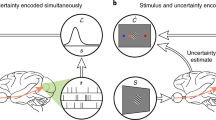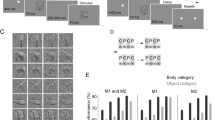Abstract
When we recognize a sensory event, we experience a confident feeling that we certainly know the perceived world 'here and now'. However, it is unknown how and where the brain generates such 'perceptual confidence'. Here we found neural correlates of confidence in the primate pulvinar, a visual thalamic nucleus that has been expanding markedly through evolution. During a categorization task, the majority of pulvinar responses did not correlate with any 'perceptual content'. During an opt-out task, pulvinar responses decreased when monkeys chose 'escape' options, suggesting less confidence in their perceptual categorization. Functional silencing of the pulvinar increased monkeys' escape choices in the opt-out task without affecting categorization performance; this effect was specific to the contralateral visual target. These data were supported by a theoretical model of confidence, indicating that pulvinar activities encode a subject's certainty of visual categorization and contribute to perceptual confidence.
This is a preview of subscription content, access via your institution
Access options
Subscribe to this journal
Receive 12 print issues and online access
$209.00 per year
only $17.42 per issue
Buy this article
- Purchase on Springer Link
- Instant access to full article PDF
Prices may be subject to local taxes which are calculated during checkout








Similar content being viewed by others
References
Peirce, C.S. & Jastrow, J. On small differences of sensation. Mem. Nat. Acad. Sci. 3, 73–83 (1884).
Seth, A.K., Baars, B.J. & Edelman, D.B. Criteria for consciousness in humans and other mammals. Conscious. Cogn. 14, 119–139 (2005).
Frith, C., Perry, R. & Lumer, E. The neural correlates of conscious experience: an experimental framework. Trends Cogn. Sci. 3, 105–114 (1999).
Sahraie, A., Weiskrantz, L. & Barbur, J.L. Awareness and confidence ratings in motion perception without geniculo-striate projection. Behav. Brain Res. 96, 71–77 (1998).
Driver, J. & Vuilleumier, P. Perceptual awareness and its loss in unilateral neglect and extinction. Cognition 79, 39–88 (2001).
Lau, H.C. A higher order Bayesian decision theory of consciousness. Prog. Brain Res. 168, 35–48 (2008).
Dehaene, S. & Changeux, J.P. Experimental and theoretical approaches to conscious processing. Neuron 70, 200–227 (2011).
Haynes, J.D., Deichmann, R. & Rees, G. Eye-specific effects of binocular rivalry in the human lateral geniculate nucleus. Nature 438, 496–499 (2005).
Tononi, G. An information integration theory of consciousness. BMC Neurosci. 5, 42 (2004).
Crick, F. & Koch, C. Constraints on cortical and thalamic projections: the no-strong-loops hypothesis. Nature 391, 245–250 (1998).
Berman, R.A. & Wurtz, R.H. Exploring the pulvinar path to visual cortex. Prog. Brain Res. 171, 467–473 (2008).
Kaas, J.H. & Lyon, D.C. Pulvinar contributions to the dorsal and ventral streams of visual processing in primates. Brain Res. Rev. 55, 285–296 (2007).
Guillery, R.W. & Sherman, S.M. Thalamic relay functions and their role in corticocortical communication: generalizations from the visual system. Neuron 33, 163–175 (2002).
Casanova, C. The visual functions of pulvinar. in The Visual Neurosciences (eds. Chalupa, L.M. & Werner, J.S.) 592–608 (MIT Press, 2003).
Shields, W.E., Smith, J.D., Guttmannova, K. & Washburn, D.A. Confidence judgments by humans and rhesus monkeys. J. Gen. Psychol. 132, 165–186 (2005).
Kornell, N., Son, L.K. & Terrace, H. Transfer of metacognitive skills and hint seeking in monkeys. Psychol. Sci. 18, 64–71 (2007).
Persaud, N., McLeod, P. & Cowey, A. Post-decision wagering objectively measures awareness. Nat. Neurosci. 10, 257–261 (2007).
Kepecs, A., Uchida, N., Zariwala, H.A. & Mainen, Z.F. Neural correlates, computation and behavioural impact of decision confidence. Nature 455, 227–231 (2008).
Kepecs, A. & Mainen, Z.F. A computational framework for the study of confidence in humans and animals. Phil. Trans. R. Soc. Lond. B 367, 1322–1337 (2012).
Olszewski, J. The Thalamus of the Macaca Mulatta, An Atlas for Use with the Stereotaxic Instrument (Karger Press, Basel, 1952).
Gutierrez, C., Cola, M.G., Seltzer, B. & Cusick, C. Neurochemical and connectional organization of the dorsal pulvinar complex in monkeys. J. Comp. Neurol. 419, 61–86 (2000).
Wilke, M., Mueller, K.M. & Leopold, D.A. Neural activity in the visual thalamus reflects perceptual suppression. Proc. Natl. Acad. Sci. USA 106, 9465–9470 (2009).
Petersen, S.E., Robinson, D.L. & Morris, J.D. Contributions of the pulvinar to visual spatial attention. Neuropsychologia 25, 97–105 (1987).
Rafal, R.D. & Posner, M.I. Deficits in human visual spatial attention following thalamic lesions. Proc. Natl. Acad. Sci. USA 84, 7349–7353 (1987).
Kastner, S. & Pinsk, M.A. Visual attention as a multilevel selection process. Cogn. Affect. Behav. Neurosci. 4, 483–500 (2004).
LaBerge, D. & Buchsbaum, M.S. Positron emission tomographic measurements of pulvinar activity during an attention task. J. Neurosci. 10, 613–619 (1990).
Saalmann, Y.B., Pinsk, M.A., Wang, L., Li, X. & Kastner, S. The pulvinar regulates information transmission between cortical areas based on attention demands. Science 337, 753–756 (2012).
Desimone, R., Wessinger, M., Thomas, L. & Schneider, W. Attentional control of visual perception: cortical and subcortical mechanisms. Cold Spring Harb. Symp. Quant. Biol. 55, 963–971 (1990).
Petersen, S.E., Robinson, D.L. & Keys, W. Pulvinar nuclei of the behaving rhesus monkey: visual responses and their modulation. J. Neurophysiol. 54, 867–886 (1985).
Benevento, L.A. & Port, J.D. Single neurons with both form/color differential responses and saccade-related responses in the nonretinotopic pulvinar of the behaving macaque monkey. Vis. Neurosci. 12, 523–544 (1995).
Robinson, D.L., McClurkin, J.W. & Kertzman, C. Orbital position and eye movement influences on visual responses in the pulvinar nuclei of the behaving macaque. Exp. Brain Res. 82, 235–246 (1990).
Malpeli, J.G. & Baker, F.H. The representation of the visual field in the lateral geniculate nucleus of Macaca mulatta. J. Comp. Neurol. 161, 569–594 (1975).
Purushothaman, G., Marion, R., Li, K. & Casagrande, V.A. Gating and control of primary visual cortex by pulvinar. Nat. Neurosci. 15, 905–912 (2012).
Bender, D.B. & Youakim, M. Effects of attentive fixation in macaque thalamus and cortex. J. Neurophysiol. 85, 219–234 (2001).
Imura, K. & Rockland, K.S. Long-range interneurons within the medial pulvinar nucleus of macaque monkeys. J. Comp. Neurol. 498, 649–666 (2006).
Romanski, L.M., Giguere, M., Bates, J.F. & Goldman-Rakic, P.S. Topographic organization of medial pulvinar connections with the prefrontal cortex in the rhesus monkey. J. Comp. Neurol. 379, 313–332 (1997).
Kiani, R. & Shadlen, M.N. Representation of confidence associated with a decision by neurons in the parietal cortex. Science 324, 759–764 (2009).
Yu, A.J. & Dayan, P. Uncertainty, neuromodulation, and attention. Neuron 46, 681–692 (2005).
Luck, S.J., Hillyard, S.A., Mouloua, M. & Hawkins, H.L. Mechanisms of visual-spatial attention: resource allocation or uncertainty reduction? J. Exp. Psychol. Hum. Percept. Perform. 22, 725–737 (1996).
Itti, L. & Baldi, P. Bayesian surprise attracts human attention. Vision Res. 49, 1295–1306 (2009).
Dayan, P., Kakade, S. & Montague, R.P. Learning and selective attention. Nat. Neurosci. 3 (suppl.), 1218–1223 (2000).
Karnath, H.O., Himmelbach, M. & Rorden, C. The subcortical anatomy of human spatial neglect: putamen, caudate nucleus and pulvinar. Brain 125, 350–360 (2002).
Zihl, J. & von Cramon, D. The contribution of the 'second' visual system to directed visual attention in man. Brain 102, 835–856 (1979).
Kunimoto, C., Miller, J. & Pashler, H. Confidence and accuracy of near-threshold discrimination responses. Conscious. Cogn. 10, 294–340 (2001).
Koch, C. & Preuschoff, K. Betting the house on consciousness. Nat. Neurosci. 10, 140–141 (2007).
Kolb, F.C. & Braun, J. Blindsight in normal observers. Nature 377, 336–338 (1995).
Inaba, N., Shinomoto, S., Yamane, S., Takemura, A. & Kawano, K. MST neurons code for visual motion in space independent of pursuit eye movements. J. Neurophysiol. 97, 3473–3483 (2007).
Komura, Y. et al. Retrospective and prospective coding for predicted reward in the sensory thalamus. Nature 412, 546–549 (2001).
Komura, Y. et al. Auditory thalamus integrates visual inputs into behavioral gains. Nat. Neurosci. 8, 1203–1209 (2005).
Crist, C.F., Yamasaki, D.S., Komatsu, H. & Wurtz, R.H. A grid system and a microsyringe for single cell recording. J. Neurosci. Methods 26, 117–122 (1988).
Kusama, T. & Mabuchi, M. Stereotaxic atlas of the brain of macaca fuscata (University of Tokyo Press, Tokyo; University Park Press, 1970).
Martin, J.H. Autoradiographic estimation of the extent of reversible inactivation produced by microinjection of lidocaine and muscimol in the rat. Neurosci. Lett. 127, 160–164 (1991).
Acknowledgements
We thank K. Kawano, S. Dehaene, R. Kanai and S. Phillips for valuable comments and critical discussions; R. Tamura and K. Numata for continuous encouragement; T. Mega and A. Muramatsu for technical help and animal care. This work was supported in part by Precursory Research for Embryonic Science and Technology program from Japan Science and Technology Agency, Grant-in-Aids for Young Scientists (A) and Scientific Research on Innovative Areas from Ministry of Education, Culture, Sports, Science and Technology, Japan (to Y.K.).
Author information
Authors and Affiliations
Contributions
Y.K. and N.H. designed the experiment. Y.K., A.N., N.H. and A.M. collected data. Y.K., A.N., T.U. and N.H. contributed to data analysis. All authors discussed the results and wrote the manuscript.
Corresponding author
Ethics declarations
Competing interests
The authors declare no competing financial interests.
Supplementary information
Supplementary Text and Figures
Supplementary Figures 1–10 (PDF 18579 kb)
Rights and permissions
About this article
Cite this article
Komura, Y., Nikkuni, A., Hirashima, N. et al. Responses of pulvinar neurons reflect a subject's confidence in visual categorization. Nat Neurosci 16, 749–755 (2013). https://doi.org/10.1038/nn.3393
Received:
Accepted:
Published:
Issue Date:
DOI: https://doi.org/10.1038/nn.3393
This article is cited by
-
Natural statistics support a rational account of confidence biases
Nature Communications (2023)
-
Studying the neural representations of uncertainty
Nature Neuroscience (2023)
-
Confidence reflects a noisy decision reliability estimate
Nature Human Behaviour (2022)
-
Thalamocortical excitability modulation guides human perception under uncertainty
Nature Communications (2021)
-
Sources of confidence in value-based choice
Nature Communications (2021)



